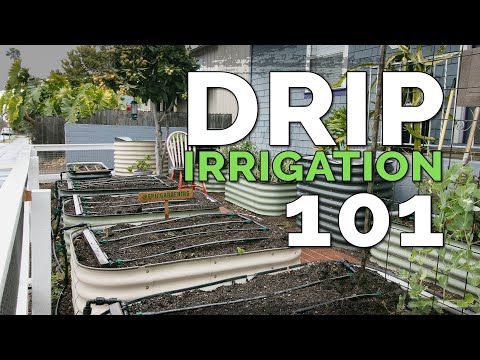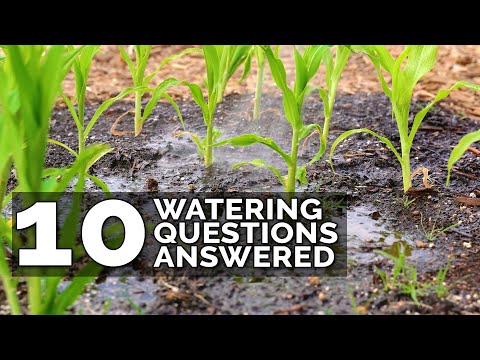Shallow vs. Deep Watering: Which is Best for Irrigation?
One of the most remarkable aspects of gardening is that each one is different from the next, suited to gardeners’ needs, tastes, aesthetics, climate, and general style. The same goes for how people water their gardens. Some of us prefer the old-school spray guns, others use drip irrigation, while some save rainwater and repurpose it to water their plants. If you’re wondering which style is best for irrigation, join organic farmer Jenna Rich as she discusses the differences between shallow and deep watering.

Contents
As we all adjust to the changing climate, gardeners have modified what they grow and how and when they irrigate their crops. We’re learning more about native and drought-resistant crops, installing irrigation systems, and transitioning to xeriscaping.
While some gardeners continue to use the trusted, old-fashioned hose and spray gun, many now combine different irrigation systems to suit their garden’s needs. Irrigation styles may change as we spend more or less time in our gardens.
Let’s first compare the two different watering styles and conclude which is better for irrigation.
Garden Oya™ Watering Pot

We have three great sizes to choose from to ensure you have the right coverage for your plants’ needs. From small to large, each one comes with a silicone lid that keeps your water in and bugs or debris out. The terracotta allows just the right amount of water to penetrate; keep your Garden Oya™ topped off and reclaim some of your time just to enjoy being in the garden instead of watering it!
What is Shallow Watering?

Shallow watering is when you water deeply but infrequently, allowing only the surfaces’ first few inches to receive moisture. Gardeners may turn on their irrigation system for 20 minutes daily. This method requires much more attention to the garden and encourages the roots to remain near the soil surface, but it may increase the risk of stress.
Shallow irrigation methods include:
- Overhead watering with a wobbler or oscillating sprinkler
- Hose and spray gun
- Watering can
Since shallow methods risk evaporation from the soil surface, apply straw mulch around crops like fruit trees, corn, lettuce, strawberries, and tomatoes to help the soil retain moisture. As a bonus, mulch will help suppress weeds and add fertility to the soil as it breaks down.
Newly planted lawns, wildflower fields, and areas recently seeded with ground cover may benefit from this type of irrigation. While it’s not the most efficient, it’s easy to throw on an overhead sprinkling system and feel confident most of the seeds receive water. I recently used this method on the property of our new home after seeding our alternative lawn and wildflower yard. During the hot summer days, I provided a quick drink of water between rainfalls. Once the seeds germinated, I allowed them to survive solely on rainfall.
Overhead, surface watering serves a purpose for folks with potted patio plants and herbs outside. These crops may just need a healthy drink of water to maintain them, not deep water.
What is Deep Watering?

Deep watering is when you water deeply less often but for extended periods. Plants become more resilient and tolerant to environmental stresses, leading to healthier, more abundant lives. Less moisture evaporates from the soil surface, so it’s more efficiently used and conserved.
Deeper methods include:
- Drip irrigation
- Soaker hoses
- Garden Oya™ Watering Pots
I deep water my high tunnel thrice weekly with a drip irrigation system for 60 to 80 minutes. The water spots between the emitters merge, and the soil surface becomes fully saturated. When I reach my hand into the soil, it is moist as far down as I can reach. The water spots may remain visible for several days, so I know the plants got a decent drink.
An ancient irrigation technique that’s making a comeback is the Garden Oya™. Fill the porous clay pot with water, then bury it at the root level in your raised bed or garden soil. Plant roots stretch down to seek moisture, attach themselves to the pot, and take what it needs. They prevent overwatering and are easy to install. Research shows this low-cost, ancient method is ten times more efficient than drip irrigation.
The main thing to remember when using an olla pot is to check it frequently for decent moisture levels, especially before leaving town. This option’s “out of sight, out of mind” highlight may be a downfall if you tend to forget about irrigating your garden in the first place. Additionally, olla pots take up quite a bit of room, which isn’t ideal for everyone.
Top Features of Each Method

| Feature | Deep Watering | Shallow Watering |
| Drip irrigation | ✔️ | |
| It can be set to a timer | ✔️ | ✔️ |
| Encourages deep roots | ✔️ | |
| Plants can seek out nutrients deep below the soil surface | ✔️ | |
| Plants become more drought-tolerant | ✔️ | |
| Reduces the risk of fungal disease | ✔️ | |
| More water conservation | ✔️ | |
| Can make gardens more firewise | ✔️ | ✔️ |
| Best for shallow-rooted plants | ✔️ | |
| Requires more attention and garden planning | ✔️ |
Shallow watering keeps water at the surface, letting the plant know it will always have a moisture supply, leaving plants vulnerable and unprepared to deal well with drought conditions.
Alternatively, deep watering forces plant roots to reach as far as eight or more inches in search of moisture, bulking up and becoming more resilient. Deeper moisture promotes a more robust and deeper root system, anchoring plants and setting them up to succeed during drought conditions.
While you can use the same system to irrigate using both methods, one is brief and more often, while the other occurs less frequently but runs for much longer. Note they can both protect land when ideal conditions for wildfires arise.
Which is Best for Irrigation?

Watering deeply with drip irrigation is the most common way to irrigate for a good reason: it’s the best technique. We often discuss the importance of a robust root system that anchors plants and helps them locate necessary nutrients. Deep irrigation is a way to promote these behaviors in plants, setting them up for a healthy and abundant season.
Allow me to give the example of deep-watering tomatoes, a popular crop growing across zones. When plants are newly transplanted, a deep soaking reduces transplant shock, encourages healthy root development, and helps them acclimate to their new space. As the plants mature and produce flowers and fruit, deep irrigating every other day for an hour or more encourages those strong roots to reach even deeper, anchoring the big plants in place, seeking nutrients, and preparing them for a hot summer.
When we side-dress with compost and granular fertilizer, earthworms are encouraged to come to the surface for the food, aerating and mixing the soil along the way. Keeping moisture off the foliage and away from the soil surface reduces the risk of fungal disease. You probably thought we were just talking about irrigating methods today, but everything we do in the garden is part of a larger circle of actions and reactions!
Frequently Asked Questions
Are there crops that prefer shallow watering?
Corn and beans have shallow roots and may benefit from frequent surface watering. Mulch will help keep that water in place and avoid evaporation. Dessert-loving cacti can survive on very little soil moisture. Fruit trees like blueberries and raspberries may seem shallow-rooted when newly planted. Still, their roots can stretch out and down several feet as they mature, making deep irrigating the advisable method to keep them healthy and happy.
How long should I run my irrigation for when deep watering?
How long to run irrigation depends on what you’re growing, your soil type, and the current forecast. Like humans, plants require more water when temperatures are high and the sun is hot. If you’re thirsty, they probably are, too! If you’re new to deep irrigation, experiment by running the water for 30 to 40 minutes, then perform the finger test to determine how moist the soil is. If your fingers come out of the soil dry after reaching down two inches, run the water longer, and if it seems soggy, water for less time in the next session.
Pro tip: Always set an alarm so you don’t forget to turn the water off. You might think you’ll remember it’s on, but learn from my mistakes.
Is deep watering suitable for small gardens?
How you water is a personal preference, and while any size garden can use these methods, it may be more practical to overhead water using a watering can or spray gun. Irrigating by hand requires more attention and more frequent sessions.
What should I grow if I don’t have an irrigation system?
Focus on native and perennial plants known to be drought tolerant and resistant to extreme sun and heat damage. Look for plants that thrive in your USDA growing zone.











